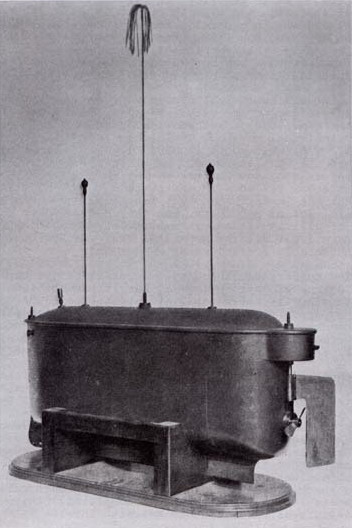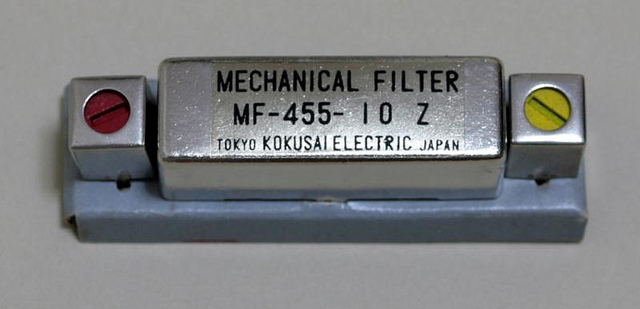|
Reed Receiver
A reed receiver or tuned reed receiver (US) was a form of multi-channel signal decoder used for early radio control systems. It uses a simple electromechanical device or '' 'resonant reed' '' to demodulate the signal, in effect a receive-only modem. The encoding used is a simple form of frequency-shift keying. These decoders appeared in the 1950s and were used into the early 1970s. Early transistor systems were in use in parallel to them, but they were finally displaced by the appearance of affordable digital proportional systems, based on early integrated circuits. These had the advantage of proportional control. Operation The decoder of the reed receiver is based on the 'resonant reed' unit. This comprises a number of vibrating metal reeds, each one having a tuned vibration frequency like a tuning fork. These reeds are manufactured from a single tapered sheet of iron or steel, giving a comb of reeds of varying length. This resembles the comb used to sound musical notes in a m ... [...More Info...] [...Related Items...] OR: [Wikipedia] [Google] [Baidu] |
Radio Control
Radio control (often abbreviated to RC) is the use of control signals transmitted by radio to remotely control a device. Examples of simple radio control systems are garage door openers and keyless entry systems for vehicles, in which a small handheld radio transmitter unlocks or opens doors. Radio control is also used for control of model vehicles from a hand-held radio transmitter. Industrial, military, and scientific research organizations make use of radio-controlled vehicles as well. A rapidly growing application is control of unmanned aerial vehicles (UAVs or drones) for both civilian and military uses, although these have more sophisticated control systems than traditional applications. History The idea of controlling unmanned vehicles (for the most part in an attempt to improve the accuracy of torpedoes for military purposes) predates the invention of radio. The latter half of the 1800s saw development of many such devices, connected to an operator by wires, inclu ... [...More Info...] [...Related Items...] OR: [Wikipedia] [Google] [Baidu] |
Octave
In music, an octave ( la, octavus: eighth) or perfect octave (sometimes called the diapason) is the interval between one musical pitch and another with double its frequency. The octave relationship is a natural phenomenon that has been referred to as the "basic miracle of music," the use of which is "common in most musical systems." The interval between the first and second harmonics of the harmonic series is an octave. In Western music notation, notes separated by an octave (or multiple octaves) have the same name and are of the same pitch class. To emphasize that it is one of the perfect intervals (including unison, perfect fourth, and perfect fifth), the octave is designated P8. Other interval qualities are also possible, though rare. The octave above or below an indicated note is sometimes abbreviated ''8a'' or ''8va'' ( it, all'ottava), ''8va bassa'' ( it, all'ottava bassa, sometimes also ''8vb''), or simply ''8'' for the octave in the direction indicated by placing ... [...More Info...] [...Related Items...] OR: [Wikipedia] [Google] [Baidu] |
Vibration Galvanometer
A vibration galvanometer is a type of mirror galvanometer, usually with a coil suspended in the gap of a magnet or with a permanent magnet suspended in the field of an electromagnet. The natural oscillation frequency of the moving parts is carefully tuned to a specific frequency; commonly 50 or 60 Hz. Higher frequencies up to 1 kHz are possible. Since the frequency depends on the mass of the moving elements, high frequency vibration galvanometers are very small with light coils and mirrors. The tuning of the vibration galvanometer is done by adjusting the tension of the suspension spring. The vibration galvanometer is used for detecting alternating currents in the frequency of its natural resonance. Most common application is as a null indicating instrument in AC bridge circuits and current comparators. The sharp resonance of the vibration galvanometer makes it very sensitive to changes in the measured current frequency and it can be used as an accurate tuning device.W. ... [...More Info...] [...Related Items...] OR: [Wikipedia] [Google] [Baidu] |
Space Modulation
{{Modulation techniques Space modulation is a radio amplitude modulation technique used in instrument landing systems (ILS) that incorporates the use of multiple antennas fed with various radio frequency powers and phases to create different depths of modulation within various volumes of three-dimensional airspace. This modulation method differs from internal modulation methods inside most other radio transmitters in that the phases and powers of the two individual signals mix within airspace, rather than in a modulator. An aircraft with an on-board ILS receiver within the capture area of an ILS, (glideslope and localizer range), will detect varying depths of modulation according to the aircraft's position within that airspace, providing accurate positional information about the progress to the threshold. Method used to determine aircraft position The ILS uses two radio frequencies, one for each ground station (about 110 MHz for LOC and 330 MHz for the GS), to transmit ... [...More Info...] [...Related Items...] OR: [Wikipedia] [Google] [Baidu] |
Institute Of Radio Engineers
The Institute of Radio Engineers (IRE) was a professional organization which existed from 1912 until December 31, 1962. On January 1, 1963, it merged with the American Institute of Electrical Engineers (AIEE) to form the Institute of Electrical and Electronics Engineers (IEEE). Founding Following several attempts to form a technical organization of wireless practitioners in 1908–1912, the Institute of Radio Engineers (IRE) was finally established in 1912 in New York City. Among its founding organizations were the Society of Wireless Telegraph Engineers (SWTE) and the Wireless Institute (TWI). At the time, the dominant organization of electrical engineers was the American Institute of Electrical Engineers (AIEE). Many of the founding members of IRE considered AIEE too conservative and too focused on electric power. Moreover, the founders of the IRE sought to establish an international organization (unlike the “American” AIEE), and adopted a tradition of electing some of ... [...More Info...] [...Related Items...] OR: [Wikipedia] [Google] [Baidu] |
Mechanical Filter
A mechanical filter is a signal processing filter usually used in place of an electronic filter at radio frequencies. Its purpose is the same as that of a normal electronic filter: to pass a range of signal frequencies, but to block others. The filter acts on mechanical vibrations which are the analogue of the electrical signal. At the input and output of the filter, transducers convert the electrical signal into, and then back from, these mechanical vibrations. The components of a mechanical filter are all directly analogous to the various elements found in electrical circuits. The mechanical elements obey mathematical functions which are identical to their corresponding electrical elements. This makes it possible to apply electrical network analysis and filter design methods to mechanical filters. Electrical theory has developed a large library of mathematical forms that produce useful filter frequency responses and the mechanical filter designer is able to make direct ... [...More Info...] [...Related Items...] OR: [Wikipedia] [Google] [Baidu] |
Joystick
A joystick, sometimes called a flight stick, is an input device consisting of a stick that pivots on a base and reports its angle or direction to the device it is controlling. A joystick, also known as the control column, is the principal control device in the cockpit of many civilian and military aircraft, either as a centre stick or side-stick. It often has supplementary switches to control various aspects of the aircraft's flight. Joysticks are often used to control video games, and usually have one or more push-buttons whose state can also be read by the computer. A popular variation of the joystick used on modern video game consoles is the analog stick. Joysticks are also used for controlling machines such as cranes, trucks, underwater unmanned vehicles, wheelchairs, surveillance cameras, and zero turning radius lawn mowers. Miniature finger-operated joysticks have been adopted as input devices for smaller electronic equipment such as mobile phones. Aviation Joystic ... [...More Info...] [...Related Items...] OR: [Wikipedia] [Google] [Baidu] |
Oscillator
Oscillation is the repetitive or periodic variation, typically in time, of some measure about a central value (often a point of equilibrium) or between two or more different states. Familiar examples of oscillation include a swinging pendulum and alternating current. Oscillations can be used in physics to approximate complex interactions, such as those between atoms. Oscillations occur not only in mechanical systems but also in dynamic systems in virtually every area of science: for example the beating of the human heart (for circulation), business cycles in economics, predator–prey population cycles in ecology, geothermal geysers in geology, vibration of strings in guitar and other string instruments, periodic firing of nerve cells in the brain, and the periodic swelling of Cepheid variable stars in astronomy. The term ''vibration'' is precisely used to describe a mechanical oscillation. Oscillation, especially rapid oscillation, may be an undesirable phenomenon in pro ... [...More Info...] [...Related Items...] OR: [Wikipedia] [Google] [Baidu] |
Escapement (radio Control)
Servos (also RC servos) are small, cheap, mass-produced servomotors or other actuators used for radio control and small-scale robotics. Most servos are rotary actuators although other types are available. Linear actuators are sometimes used, although it is more common to use a rotary actuator with a bellcrank and pushrod. Some types, originally used as sail winches for model yachting, can rotate continuously. Construction A typical servo consists of a small electric motor driving a train of reduction gears. A potentiometer is connected to the output shaft. Some simple electronics provide a closed-loop servomechanism. Operation The position of the output, measured by the potentiometer, is continually compared to the commanded position from the control (i.e., the radio control). Any difference gives rise to an error signal in the appropriate direction, which drives the electric motor either forwards or backwards, and moving the output shaft to the commanded position. When ... [...More Info...] [...Related Items...] OR: [Wikipedia] [Google] [Baidu] |
Carrier Wave
In telecommunications, a carrier wave, carrier signal, or just carrier, is a waveform (usually sinusoidal) that is modulated (modified) with an information-bearing signal for the purpose of conveying information. This carrier wave usually has a much higher frequency than the input signal does. The purpose of the carrier is usually either to transmit the information through space as an electromagnetic wave (as in radio communication), or to allow several carriers at different frequencies to share a common physical transmission medium by frequency division multiplexing (as in a cable television system). The term originated in radio communication, where the carrier wave creates the waves which carry the information (modulation) through the air from the transmitter to the receiver. The term is also used for an unmodulated emission in the absence of any modulating signal. In music production, carrier signals can be controlled by a modulating signal to change the sound property of ... [...More Info...] [...Related Items...] OR: [Wikipedia] [Google] [Baidu] |
Spread Spectrum
In telecommunication and radio communication, spread-spectrum techniques are methods by which a signal (e.g., an electrical, electromagnetic, or acoustic signal) generated with a particular bandwidth is deliberately spread in the frequency domain, resulting in a signal with a wider bandwidth. These techniques are used for a variety of reasons, including the establishment of secure communications, increasing resistance to natural interference, noise, and jamming, to prevent detection, to limit power flux density (e.g., in satellite downlinks), and to enable multiple-access communications. Telecommunications Spread spectrum generally makes use of a sequential noise-like signal structure to spread the normally narrowband information signal over a relatively wideband (radio) band of frequencies. The receiver correlates the received signals to retrieve the original information signal. Originally there were two motivations: either to resist enemy efforts to jam the communications ( ... [...More Info...] [...Related Items...] OR: [Wikipedia] [Google] [Baidu] |




